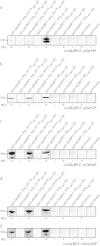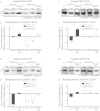The Phosphorylation Profile of Myosin Binding Protein-C Slow is Dynamically Regulated in Slow-Twitch Muscles in Health and Disease
- PMID: 26285797
- PMCID: PMC4642540
- DOI: 10.1038/srep12637
The Phosphorylation Profile of Myosin Binding Protein-C Slow is Dynamically Regulated in Slow-Twitch Muscles in Health and Disease
Erratum in
-
Corrigendum: The Phosphorylation Profile of Myosin Binding Protein-C Slow is Dynamically Regulated in Slow-Twitch Muscles in Health and Disease.Sci Rep. 2018 May 11;8:46969. doi: 10.1038/srep46969. Sci Rep. 2018. PMID: 29749391 Free PMC article.
Abstract
Myosin Binding Protein-C slow (sMyBP-C) is expressed in skeletal muscles where it plays structural and regulatory roles. The functions of sMyBP-C are modulated through alternative splicing and phosphorylation. Herein, we examined the phosphorylation profile of sMyBP-C in mouse slow-twitch soleus muscle isolated from fatigued or non-fatigued young (2-4-months old) and old (~14-months old) wild type and mdx mice. Our findings are two-fold. First, we identified the phosphorylation events present in individual sMyBP-C variants at different states. Secondly, we quantified the relative abundance of each phosphorylation event, and of sMyBP-C phospho-species as a function of age and dystrophy, in the presence or absence of fatigue. Our results revealed both constitutive and differential phosphorylation of sMyBP-C. Moreover, we noted a 10-40% and a 25-35% reduction in the phosphorylation levels of select sites in old wild type and young or old mdx soleus muscles, respectively. On the contrary, we observed a 5-10% and a 20-25% increase in the phosphorylation levels of specific sites in young fatigued wild type and mdx soleus muscles, respectively. Overall, our studies showed that the phosphorylation pattern of sMyBP-C is differentially regulated following reversible (i.e. fatigue) and non-reversible (i.e. age and disease) (patho)physiological stressors.
Figures







References
-
- Ackermann M. A., Hu L.-Y. R., Bowman A. L., Bloch R. J. & Kontrogianni-Konstantopoulos A. Obscurin interacts with a novel isoform of MyBP-C slow at the periphery of the sarcomeric M-band and regulates thick filament assembly. Molecular biology of the cell 20, 2963–2978, 10.1091/mbc.E08-12-1251 (2009). - DOI - PMC - PubMed
-
- De Tombe P. P. Myosin binding protein C in the heart. Circ Res 98, 1234–1236, 98/10/1234 (2006). - PubMed
Publication types
MeSH terms
Substances
Grants and funding
LinkOut - more resources
Full Text Sources
Other Literature Sources
Medical

